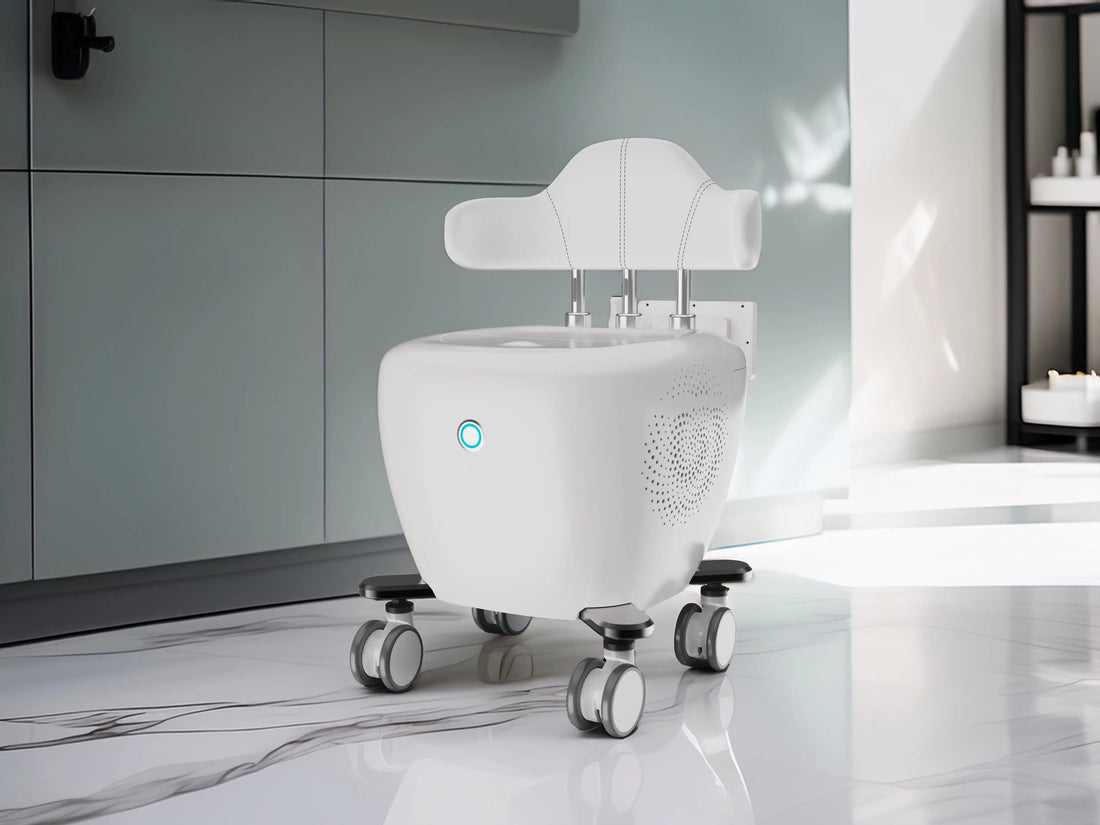
Restauration de la continence et de la confiance | Étude de cas du fauteuil pelvien Supramax
Comparter
Restauration de la continence et de la confiance : une étude de cas utilisant la chaise Supramax chez une femme de 75 ans souffrant d'incontinence double post-hystérectomie et d'antécédents médicaux complexes
Par Katie Govind, infirmière prescriptrice indépendante. Infirmière diplômée. K Govind Medical Aesthetics
Résumé
Cette étude de cas présente l'utilisation réussie de la thérapie électromagnétique focalisée à haute intensité via la chaise pelvienne Supramax de Pure Tone Aesthetics pour traiter une incontinence urinaire et fécale de longue date chez une femme de 75 ans avec un historique médical complexe, incluant une néoplasie myéloproliférative, une diverticulite, une chimiothérapie antérieure, et une hystérectomie totale.
Malgré près de deux décennies d'incontinence et aucune amélioration durable avec les interventions médicales traditionnelles, cette patiente a obtenu des résultats transformateurs tant au niveau des symptômes que de la qualité de vie grâce à un programme structuré de renforcement du plancher pelvien.
Profil du patient
- Nom : Patiente B (pseudonyme)
- Âge : 75 ans
- Antécédents médicaux pertinents :
- Un accouchement naturel (1992)
- Hystérectomie totale (2006)
- Diagnostic post-opératoire d'incontinence double
- Néoplasie myéloproliférative (NMP) – Thrombocytémie essentielle avec mutation 5q- et JAK2
- Chimiothérapie intermittente ; dernier cycle il y a 12 mois
- Diverticulite suspectée
- Suivi actif par une équipe de continence depuis 2006, avec amélioration minimale sous médicaments et physiothérapie
Symptômes
- Écoulement urinaire constant
- Urgence fréquente avec incontinence fécale occasionnelle
- Incontinence nocturne nécessitant un changement de protection toutes les heures
- Niveaux élevés d'anxiété, perturbation du sommeil et retrait social
Objectifs du traitement
- Renforcer la musculature du plancher pelvien pour améliorer le contrôle de la vessie et des intestins
- Réduire ou éliminer l'écoulement et l'urgence
- Restaurer la qualité du sommeil et réduire la dépendance aux protections
- Améliorer le bien-être psychologique et la confiance en soi
Plan de traitement & technologie utilisée
Chaise pelvienne Supramax de Pure Tone Aesthetics — délivre une stimulation électromagnétique focalisée à haute intensité pour induire des contractions pelviennes supramaximales.
Protocole de traitement
- Phase 1 : séances bihebdomadaires pendant 8 semaines (28 minutes par séance)
- Phase 2 : séances hebdomadaires pendant 4 semaines supplémentaires
- Phase 3 : entretien — la patiente assiste désormais à deux séances par mois
- Progression : début sur réglages débutants, progression rapide vers des intensités plus élevées.
- Tolérance : traitement bien toléré tout au long ; aucun effet indésirable rapporté.
Progrès cliniques
Semaine 3
- La patiente peut dormir jusqu'à 6 heures la nuit avec seulement des protections humides
- Urgence significativement réduite
- Arrive à atteindre les toilettes la plupart du temps
- Signale encore un écoulement diurne, mais moins fréquent
Semaine 8
- Peut désormais dormir toute la nuit sans avoir besoin d'uriner
- L'écoulement a complètement cessé
- L'urgence intestinale est nettement améliorée ; moins d'épisodes de fuites
- Ne craint plus de sortir de chez elle
- Bien-être psychologique visiblement amélioré
Entretien continu
- Assiste à la clinique deux fois par mois pour maintenir le tonus musculaire
- Décrit sa continence comme « contrôlée et gérable »
- Signale une activité accrue, un meilleur sommeil et une confiance retrouvée
Témoignage de la patiente
« Je n'avais pas fait une nuit complète depuis des années jusqu'à maintenant. Je changeais de protection toutes les heures pendant la nuit. Maintenant, je dors toute la nuit et je n'ai plus peur de sortir. Ma confiance a explosé. » — Patiente B
Réflexions cliniques
Ce cas souligne le potentiel transformateur de la technologie électromagnétique focalisée à haute intensité dans le traitement des troubles fonctionnels du plancher pelvien, en particulier chez les patients ayant échoué aux thérapies conventionnelles. Malgré près de 20 ans d'incontinence, de multiples comorbidités et un historique de chimiothérapie, la patiente B a obtenu des résultats auparavant inaccessibles avec les soins médicaux traditionnels seuls.
Il est important de noter que ce cas illustre que l'âge et la complexité ne sont pas des contre-indications à la rééducation du plancher pelvien. La chaise pelvienne Supramax nous a permis de proposer une intervention non invasive, indolore et efficace qui a comblé le fossé entre les soins médicaux et la restauration fonctionnelle.
Conclusion
Ce cas remet en question l'idée que l'incontinence chez les femmes âgées est une conséquence inévitable du vieillissement ou de la chirurgie. Avec les bons outils et une approche empathique centrée sur la patiente, nous pouvons restaurer non seulement la continence mais aussi la dignité et la confiance.
Chez K Govind Medical Aesthetics, nous sommes fiers de promouvoir des soins innovants et holistiques qui apportent un changement significatif — physiquement, émotionnellement et socialement.
À propos de l'auteur
Katie Govind est la fondatrice et responsable clinique de K Govind Medical Aesthetics. Avec une formation en soins infirmiers et une passion pour les soins holistiques et éthiques, elle se spécialise dans l'utilisation de technologies non invasives pour améliorer les résultats esthétiques et fonctionnels. Sa pratique fait le lien entre les soins médicaux et esthétiques, en donnant du pouvoir aux femmes à chaque étape de leur vie.
En savoir plus sur la chaise pelvienne Supramax ici



